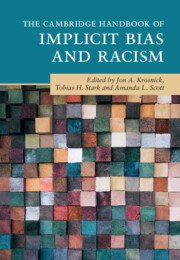Book contents
- The Cambridge Handbook of Implicit Bias and Racism
- Cambridge Handbooks in Psychology
- The Cambridge Handbook of Implicit Bias and Racism
- Copyright page
- Contents
- Figures
- Tables
- Contributors
- Foreword
- Taking Stock of Explicit and Implicit Prejudice
- 1 Report from the NSF Conference on Implicit Bias
- Section I What is Implicit Bias and (How) Can We Measure It?
- Section II Do Measures of Implicit Bias Predict Cognition and Behavior?
- Section III Challenges of Research on Implicit Bias
- Introduction
- 11 The Rationality, Interpretation, and Overselling of Tests of Implicit Cognition
- 12 Listening to Measurement Error: Lessons from the Implicit Association Test
- 13 IAT Scores, Racial Gaps, and Scientific Gaps
- 14 Commentary
- Section IV Improving Measurement and Theorizing About Implicit Bias
- Section V How to Change Implicit Bias?
- Section VI Explicit Prejudice; Alive and Well?
- Section VII The Public’s (Mis)understanding of Implicit Bias
- Index
- References
13 - IAT Scores, Racial Gaps, and Scientific Gaps
from Section III - Challenges of Research on Implicit Bias
Published online by Cambridge University Press: 21 December 2024
- The Cambridge Handbook of Implicit Bias and Racism
- Cambridge Handbooks in Psychology
- The Cambridge Handbook of Implicit Bias and Racism
- Copyright page
- Contents
- Figures
- Tables
- Contributors
- Foreword
- Taking Stock of Explicit and Implicit Prejudice
- 1 Report from the NSF Conference on Implicit Bias
- Section I What is Implicit Bias and (How) Can We Measure It?
- Section II Do Measures of Implicit Bias Predict Cognition and Behavior?
- Section III Challenges of Research on Implicit Bias
- Introduction
- 11 The Rationality, Interpretation, and Overselling of Tests of Implicit Cognition
- 12 Listening to Measurement Error: Lessons from the Implicit Association Test
- 13 IAT Scores, Racial Gaps, and Scientific Gaps
- 14 Commentary
- Section IV Improving Measurement and Theorizing About Implicit Bias
- Section V How to Change Implicit Bias?
- Section VI Explicit Prejudice; Alive and Well?
- Section VII The Public’s (Mis)understanding of Implicit Bias
- Index
- References
Summary
In this chapter we identify scientific gaps research to date regarding the ability of IAT scores to explain real world racial gaps. We use the term “IAT scores” rather than “implicit bias” because, as we show: (1) Implicit bias has no consensual scientific definition; (2) A definition offered by Greenwald (2017) is shown to be logically incoherent and empirically unjustified; (3) Exactly what the IAT measures remains unclear. Nonetheless, meta-analyses have shown that IAT scores predict discrimination to a modest extent. Alternative explanations for gaps are briefly reviewed, highlighting that IAT scores offer only one of many possible such explanations. We then present a series of heuristic models that assume that IAT scores can only explain what is left over, after accounting for other explanations of gaps. This review concludes that IAT scores probably explain a modest portion of those gaps. Even if the IAT captures implicit biases, and those implicit biases were completely eliminated, the extent to which racial gaps would be reduced is minimal. We conclude by arguing that, despite its limitations, the IAT should not be abandoned, but that, even after twenty years, much more research is needed to fully understand what the IAT measures and explains.
Keywords
- Type
- Chapter
- Information
- The Cambridge Handbook of Implicit Bias and Racism , pp. 374 - 411Publisher: Cambridge University PressPrint publication year: 2025
References
- 1
- Cited by

